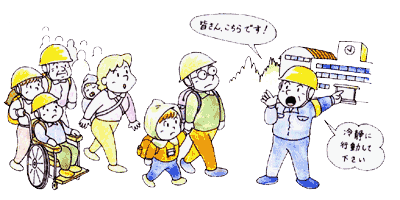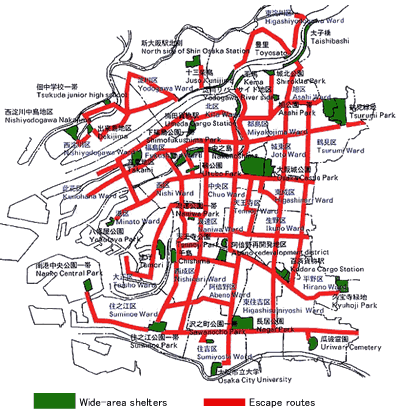 |
After an Earthquake: Steps and Actions
IF A FIRE OCCURS
- Generally, it is possible to extinguish a fire with a fire extinguisher before the flames reach the ceiling. Besides the fire extinguisher, utilize stored water and sheets soaked in water.
- When a fire starts, try to fight the fire, while calling out to inform your family and neighbors of the fire, and ask them to dial 119 from a safe place.
- If it becomes too dangerous, call out to people nearby and evacuate the area. Smoke contains noxious gases such as carbon monoxide (CO) so keep low and cover your nose and mouth with a handkerchief or a towel.
How to Use A Fire Extinguisher
- Pull out the safety plug. Stand approximately 3-5 meters away from the fire.
- Aim the hose nozzle at the base of the fire.
- Depress the lever. Aim directly at the source of the fire. Spraying the smoke or flames will not extinguish the fire.

IF YOU ARE TRAPPED
- Find a piece of metal and hit it against another piece of metal (pots and fry pans) to make loud noises to let others know where you are.
- It is important for persons in the community to cooperate with each other for rescue operations in the early stages. Utilize household carpentry tools and the rescue equipment provided at schools which are specified as refuge centers.
WHEN ESCAPING
- Call out to those who need assistance and ask your neighbors for help. Then leave in a group.
- Be sure to shut off the gas supply cock and turn off electric breakers.
- Attach a sheet of paper to the entrance of your house to indicate where you have gone. Lock all doors and windows.
- Avoid using a car. Leave on foot.
- Prepare durable or tough footgear and change into comfortable clothing.
OSAKA CITY MEASURES - SHELTERS AND ESCAPE ROUTES -
- When a disaster such as an earthquake occurs and evacuation is judged to be unavoidable, the Mayor and ward directors will give announcements and directions.
- Announcements and directions will be announced over loud speakers installed at schools and ward offices.
- Temporary shelters: Schools, parks and such can be used as temporary shelters.
- Accommodation shelters: Buildings that are able to accommodate those that seek refuge.
- Wide- area shelters: In the event of a severe fire, parks and such areas have been designated as appropriate large scale refuges.
- Escape routes: Safe routes leading to wide-area shelters.


TO OBTAIN CORRECT INFORMATION
- In general, aftershocks are said to be weaker than the main earthquake so it should be possible to carefully check out the state of your house and its surrounding area without too much concern for the after-shocks.
- Afterwards, NHK and private broadcasting stations will broadcast information about the earthquakes, tidal waves, and damages. Listen to the radio and TV for information.
- Refrain from acting according to rumors. Confirm any information through administrative channels or the media.
- If many telephone calls from inside and outside the disaster area flood into city offices, ward offices, police stations, and fire stations to confirm the safety of family members and acquaintances, actual emergency and rescue telephone calls cannot reach these locations. Avoid making telephone calls which are unnecessary.
|